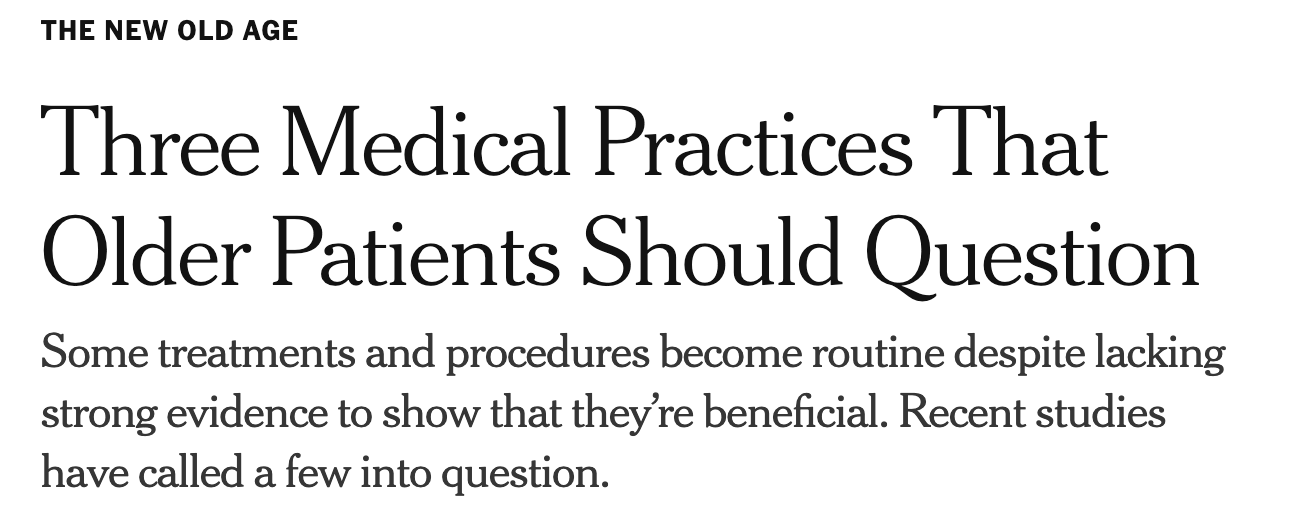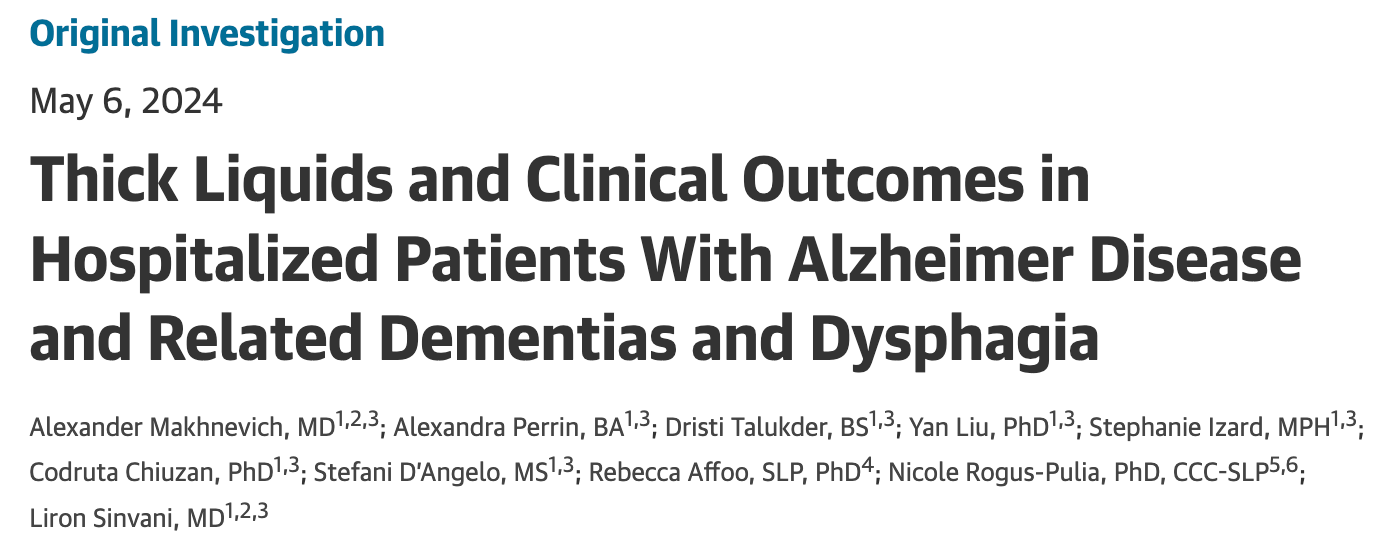Thickened Liquids for Older Adults is Likely a Useless Therapy, but a Current Study Cannot Prove It.
The study of the week explores the common mistake of making causal leaps from non-randomized observational studies
Few things interest my writing brain more than when a common practice gets overturned.
That’s why I was drawn to Paula Span’s column in the New York Times titled, Three Medical Practices That Older Patients Should Question.
One of these practices is the prescription of thickened liquids to older patients with swallowing problems. The idea goes like this: aspiration pneumonia is a common cause of death in the frail and elderly. IOW: stuff goes down the wrong pipe.
Regular liquids, like coffee, or water, or soft drinks are more likely to be aspirated into the lungs. So clinicians, always the mechanistic thinkers, came up with the idea of giving these patients thickened liquids.
Thing is that these taste terrible. Patients may stop taking in fluids—which is the last thing you want an already frail underweight elderly person to do.
A few years ago, a group at the University of California San Francisco started a thickened liquid challenge, wherein they had doctors and nurses consume thickened liquids for 12 hours. It was an eye-opener because the prescribers experienced how bad their prescription tasted. Think of your Americano as a paste.
The New York Times’ piece included this line:
Now, a large-scale study from the Feinstein Institutes for Medical Research in Manhasset, N.Y., has found that liquid thickening doesn’t actually help such patients.
When I read that sentence—with its action verbs “has found” and “doesn’t help”—I thought, thank goodness, we have another randomized trial overturning a common practice.
But this was not the case. The study that Ms Span referred to was indeed large in scale, but it was not capable of overturning the thickened liquid policy. Darn it.
In the study by Makhnevich and colleagues, the team included adults with dementia who were admitted to 11 diverse hospitals in New York. All patients had suspicion of swallowing issues.
The team then created two groups for comparison. One group were patients who received at least 75% of their diet consisting of a thick liquid. The other group had a normal thin liquid diet.
The primary outcome was death in the hospital. Other outcomes included respiratory complications (pneumonia), intubation and hospital length of stay (LOS).
Of course, because the two groups were not randomized, the research team had to use statistical adjustments in an attempt to make the two groups as similar as possible. They did this with a technique called propensity matching. They had about 4500 patients in each group.
Results
They found no significant difference in the primary outcome of death.
The hazard ratio was 0.92, indicating that the thin liquid group had an 8% lower rate of death. But that point estimate did not come close to being statistically significant; the 95% confidence intervals went from 0.75 or 25% better for the thin liquids to 1.14 or 14% worse for the thin liquids.
The components of the primary outcome went in different directions. Intubation was lower with thin liquids, but respiratory complications were higher with thin liquids. Intubation is (sort of) a respiratory complication, so this suggests noisy data.
One interesting aspect of the study emphasizes how the analytic method can change results. I wrote about a paper from Dr Dena Zeraatker, from McMaster University which found there were oodles of ways to analyze data, and different methods led to different results.
When the authors used a different method for matching the two non-randomized groups—with something called inverse probability of treatment weighting—they found that mortality was actually 5% higher in the thin liquid group. This also did not reach statistical significance.
The authors, and perhaps the reviewers and editors, deserve immense praise for their conclusion.
While Ms Span concluded in the New York Times that thickened liquids did not help patients, the authors concluded something much more accurate—and extremely rare in the medical literature.
This cohort study emphasizes the need for prospective studies that evaluate whether thick liquids are associated with improved clinical outcomes in hospitalized patients with dementia and dysphagia.
Comments:
This is the best conclusion I have seen this year. They did not write that since there was no difference in outcomes in the thickened liquid group, and thickened liquids taste terrible, we should stop prescribing it.
They wrote—basically—that their findings were inconclusive. In the first paragraph of their discussion, they added that due to the retrospective nature of the study, the results should not be used to change management.
I don’t see the look-back nature of the study as its biggest limitation.
To me, the core problem is that the groups were not randomized. A clinician had to choose whether or not to prescribe thickened liquids. There were many reasons that went into that decision—some on the datasheet, and therefore adjustable, but some clearly not on a datasheet.
The problem with unaccounted variables in the two groups is that we don’t know if it was one of those variables that accounted for the findings vs the thickened liquids. And because there were surely baseline differences in the two groups it would be wrong to conclude that there was no improvement with thickened liquids.
In fact, anytime a study looks at two groups wherein a clinician (not randomization) chooses a therapy, it becomes super-hard, perhaps impossible, to compare outcomes in the two groups. Some experts think that in rare cases, causal interpretation is possible, but that is debatable.
While I highly doubt thickened liquids lead to better outcomes, this study should not be cited as a reason to question the therapy. The methods don’t support that claim.
But. But. There is another important lesson here.
A better way forward in the prevention of aspiration pneumonia would have been to perform a proper randomized trial before implementing such a noxious policy. Before we do something to people that we would not accept, it should pass muster in a proper trial. Then, if the intervention really does help people, it might be worth it.
Now that thickened liquids have become a therapeutic fashion, it is harder to overturn. JMM




The phrase “thickened liquids” in and of itself just sounds gross. I guess I’ll take quality over quantity. If I’m at that point where I need thickened liquids (so gross!!!!), I’ll take my chances.
When my mother was put on thickened liquids she hated them. They tried to thicken the good take out coffee I bought for her when she was in rehab and I refused to allow it. That was the first time she smiled in weeks. When she went to assisted living my siblings and I all signed a letter stating that our mother did not want thickened liquids, and as long as she was allowed to drink any liquid she wanted, we would not hold the facility or its staff responsible for her aspirating. It worked. She did NOT die of aspiration or choking.